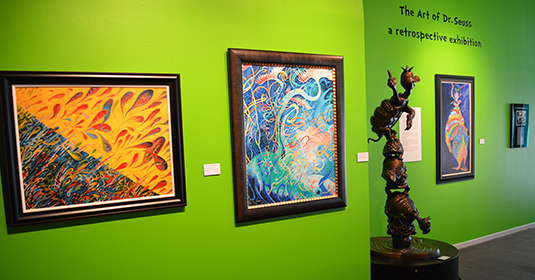By Darla Harmon, executive director
Thirty years ago, the Center for Contemporary Arts was born of a grand idea by international photographer Bill Wright and local Abilene arts supporter Lynn Barnett.
 Their desire to have a place in Abilene where artists could work, commune, inspire and present their original works of art culminated in the birth of the Artists League of Texas in 1984. This year marks the 25th anniversary of a co-op of local and regional artists who came together and carved a niche for themselves into the fabric of Big Country art offerings. Here in this unlikely place was created a synergistic gathering of cutting-edge contemporary artists.
Their desire to have a place in Abilene where artists could work, commune, inspire and present their original works of art culminated in the birth of the Artists League of Texas in 1984. This year marks the 25th anniversary of a co-op of local and regional artists who came together and carved a niche for themselves into the fabric of Big Country art offerings. Here in this unlikely place was created a synergistic gathering of cutting-edge contemporary artists.
The Center for Contemporary Arts will be planning several special events throughout the year in honor of its 25th anniversary.
The Center has long been a home for cutting-edge art. The dust and idiosyncratic ideals which can creep into your soul here in West Texas have inadvertently stimulated an art form not unlike a great wind, pushing sometimes pleasant, other times uncomfortable, visions into our lives that give us pause. It is this one singular moment where contemporary art finds its chi. Not so much a revolution as a reaction to what is, what has been and perhaps what is to be.
The Artists League of Texas was initially conceived to help promote the arts in the community. A few of the founding artists – Tony Brown, Steve Butman, Linda Fawcett, Martha Kiel, Van LeBus, Larry Millar, Linda Murray and Bill Wright – continue to be an integral part of the Center today.
The first home of the Artists League of Texas was above Roberts Photography Studio on N. 2nd Street. In the beginning, it was the artists who scraped paint, painted walls, cleaned floors, installed the exhibitions, sat the gallery and raised funds to support their fledgling organization with the help of the Abilene Cultural Affairs Council under Barnett’s leadership. Because of the success of the organization, the artist membership soon realized they needed to take the next step in their evolution. Due to the lack of handicap-accessible facilities and the desire to grow, the Artists League of Texas formed The Center for Contemporary Arts in 1989. Paperwork was filed with the state of Texas, the name was changed and soon the move was made to 220 Cypress St. (The move was accomplished by the strong backs of the Artist Membership.)
This transition allowed the Center to embrace the return of a hometown son who had made it big in the Big Apple, none other than Clint Hamilton.
The Clint years gave the Center the relevance to push its boundaries. His unique style and experience in the world of pop art brought an infectious energy and excitement. Clint’s art and style were something of a phenomenon here in Abilene. His work lacked stoicism and ambiguity. Clint’s use of color and found objects was inspired by the Dada movement in the 1950s. Collage and assemblage dominated his style.
Rather than starve when he went to New York early in his career, Clint became a window dresser with successful showings in Bonwit-Teller and Tiffany’s. When he returned to Texas in the 1960s, he worked for Neiman-Marcus and Grissom’s Department Store, which is ironically located in the same building that houses the Center today.
Clint’s studio was housed in what is now Gallery 4 of the Center for Contemporary Arts. After a devastating heart attack and recovery, Clint’s studio was moved in its entirety to the Museums of Abilene main gallery in 1998.
With growth and expansion, the Center for Contemporary Art has been much like a butterfly emerging from a cocoon. Walls have been installed, removed, painted patched, wrapped with canvas and provided backdrop for thousands of wonderful works of art by Abilene’s very own artists.
Today, the Center boasts an artist membership of approximately 70 members from the Big Country. These artists work tirelessly at their craft–honing it, polishing it and constantly using their art as a voice from their soul. The Center has 10 studios where artists can be found plying their craft on a daily basis.
Murray, for example, can be found in her studio daily, steeping herself in her art. She embraces the occasional visitor, explaining why she has to paint. It is not an option for her; it is as much a part of her as breathing.
Murray has spoken of the “old” days as being wild, fresh and crazy. A group of artist members including Murray, Larry Millar, Linda Fawcett, Alice Leese, Clint Hamilton, Tony Brown and others painted the world’s largest black velvet painting, “Mayonnaise, Olympia.” Their masterpiece was written up in Texas Monthly with a photo and mentioned in the Dallas Morning News and the San Antonio Light. The debut of this piece was at a David Durham-sponsored benefit celebrating the publishing of Sam Pendergrast’s book “Avenida Juarez: A Novel.”
For 25 years, artist members have remained faithful to the mission and the cause of the Center.
Its vision has not been watered down or rubbed smooth, which can happen when organizations begin to age. The Center for Contemporary Arts has maintained its sharp edge, presenting work that is thought provoking, beautiful, terrifying, angry, passionate, and always just a little closer to the edge of what might be considered “normal.”
The goal of the Center for Contemporary Arts is to be ground zero for contemporary art in West Texas. Rather than slip quietly into history, the Center will be screaming in to the next 25 years with a body of work produced by Texas contemporary artists who will engage the viewer in a visceral conversation through sensations not yet explored. The ride will be challenging, but worth the work.
The Center is grateful to all of those who helped shape it into what it has become. And as we move further into the 21st century, you can count on the Center to continue to explore, challenge, provoke conversations and help the community to embrace the importance of contemporary art to our world.

























Leave a Reply